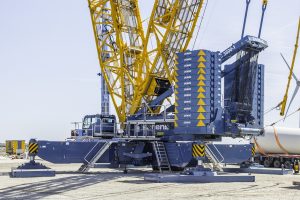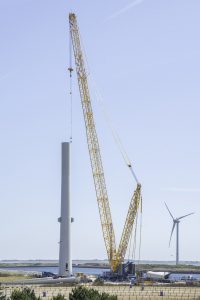 On behalf of customer Enercon, crane service provider Sarens was scheduled to erect two wind turbines at the Bouwdokken wind farm close to the Dutch North Sea village of Vrouwenpolder. Project preparation and execution posed a challenge, as the location of both wind turbines was right next to the Neeltje Jans amusement park, which was scheduled to open April 1st and was under no circumstance to be disrupted by the project execution. This is why Sarens used a separate crane for each wind turbine so as to complete the job as quickly as possible, with the units being a Demag® CC 3800-1 crawler crane and a PC 3800-1 pedestal crane.
On behalf of customer Enercon, crane service provider Sarens was scheduled to erect two wind turbines at the Bouwdokken wind farm close to the Dutch North Sea village of Vrouwenpolder. Project preparation and execution posed a challenge, as the location of both wind turbines was right next to the Neeltje Jans amusement park, which was scheduled to open April 1st and was under no circumstance to be disrupted by the project execution. This is why Sarens used a separate crane for each wind turbine so as to complete the job as quickly as possible, with the units being a Demag® CC 3800-1 crawler crane and a PC 3800-1 pedestal crane.
The Demag PC 3800-1 is the pedestal counterpart to the CC 3800-1. Both cranes are unquestionably strong representatives of the 650-tonne capacity class, although the PC 3800-1 admittedly outperforms the crawler version in terms of load moment: At 66.918 ft-kips, it is slightly larger than that of the CC 3800-1, which comes in at 66.196 ft-kips. The pedestal version’s most outstanding characteristic, however, is its excellent ability to perform work at sites where the ground is uneven: While crawler cranes need a large and perfectly straight surface with a gradient of 0 to 0.3 degrees in order for an operator to be able to use their full rated lifting capacity, the PC 3800-1 only needs four load-bearing surfaces for its outrigger supports, and even these surfaces do not need to be perfectly aligned with each other. The reason for this is that the outrigger cylinders are able to compensate for small differences without a problem – up to 2.1 degrees on a 12 x 12 meter support area. This means that the pedestal crane requires significantly less ground preparation. “This has made the PC 3800-1 absolutely indispensable time and time again,” explains Sarens Project Manager Pascal van der Spoel, who not only used the two Demag siblings at the work site, but also an impressive fleet of additional cranes: “We also had two 200-tonne and two 500-tonne all terrain cranes there, as well as an additional 200-tonne crawler crane, and we used them primarily to unload and pre-assemble components,” reports Pascal van der Spoel, who was in charge of a team of up to 15 people at the site.
A Tight Schedule
Given the April 1st deadline, the Sarens team only had ten weeks to complete its work at the wind farm, and that included unloading, pre-assembling, and erecting the wind turbines. “However, we were aware that the work site was located in a windy region between the Eastern Scheldt and the North Sea, so we’d already scheduled in a time buffer in order to compensate for any delays caused by heavy winds,” explains Project Manager van der Spoel, whose team worked with the Zweibrücken factory beforehand in order to confirm the maximum permissible wind speeds for work with both cranes for specific crane configurations. In addition, the Sarens team built special fixtures to be able to safely set down the main boom on the ground if necessary due to heavy winds.
The team also had to face another challenge: The work site was located right in the middle of a breeding ground for birds that is also part of the Delta Works, a system of construction projects in Zeeland designed to protect against floods and storm surges. Accordingly, the area enjoys special protection by the Dutch Ministry of Infrastructure and Water Management and there were various requirements that needed to be met before work could be carried out. “On top of that, there wasn’t enough space to store and prepare everything on the amusement park grounds. All the mentioned circumstances Sarens had to take into consideration obviously put additional pressure on us to finish the project within a tight deadline,” van der Spoel points out.
Ideal “Wind Turbine Cranes”
All of this meant that his team had to be able to be flexible and count on the two cranes’ reliability and performance – and hope for good weather. Then again, no one in the team had any doubts concerning the cranes. In fact, everyone knew that with a lifting capacity of 715 USt at a radius of 39.4 feet and a maximum load moment of over 66 ft-kips, the Demag PC 3800-1 and the CC 3800-1 were more than powerful enough to erect the wind turbines without a problem. “And that’s actually one of the reasons why we decided to use the two Demag cranes for the job,” van der Spoel explains. The PC 3800-1 was set up with an LSL 11 configuration with a 413.3 foot boom length, while the CC 3800-1 was set up with an LSL 12 configuration with a 383.9 foot boom plus a 39.3 foot extension.
… with Power and Precision
While the wind turbine components were brought to the work site by ships, the cranes got there by land: The PC 3800-1 from a wind farm in Spain and the CC 3800-1 from Metz, where it had been used to help build a soccer stadium. Once at the Bouwdokken wind farm, the two cranes were able to truly shine together with lifting heights of up to 328 feet and loads weighing up to 165 USt. Erecting the wind turbines required lifting eleven components for each: five tower elements, plus the nacelle, generator, hub, and three rotor blades. Since all the components were unloaded from the ships in a horizontal position, they first needed to be brought to a vertical position for the lifts. An assist crane was used for this purpose. The complexity of the execution comes with good preparation, and defining the right equipment, a process Sarens follows on every project and has become a professional routine for the Sarens team. “The two large Demag cranes took care of the lifts smoothly thanks to their enormous power and high precision. Just like we knew they would,” Pascal van der Spoel happily summarizes after mentioning that he was never once worried about not completing the work on time.

About the Sarens Group
The Sarens Group, which is headquartered in the Belgian town of Wolvertem, employs around 4,000 people and is one of the world’s leading providers of crane and heavy load transportation services. Its customers include companies from the petroleum and gas production industries, the energy industry, the petrochemical industry, and the mining industry. In addition, the company has a separate business unit that specializes in the erection of onshore and offshore wind turbines. Sarens enjoys an outstanding reputation as an unrivaled business partner in every single one of these industries, and all the more so when large-scale, complex lifting projects are involved. The family-run enterprise, which was founded in the 1930s, now boasts 100 branch offices in five continents.
For more information, please visit www.sarens.com
Demag
Newly part of the Tadano Group, the Demag brand embodies a 200-year legacy of providing intelligent and innovative lifting solutions. Demag’s city, all terrain, and lattice boom crawler cranes offer capacities from 45 t to 3,200 t (50 to 3,520 USt), helping customers to enhance their lifting efficiencies on a range of infrastructure, renewable energy, building and heavy civil construction, utilities, and refining applications. Innovations like Sideways Superlift, Boom Booster, the award-winning Fall Protection, IC-1 Remote, and IC-1 Plus technologies contribute to machine performance, safety, and efficiency. Global Demag sales and service networks provide unmatched experience, high reliability, and short response times. More information on Demag Mobile Crane equipment, services, and technologies can be found on the web at www.demagmobilecranes.com, on LinkedIn at www.linkedin.com/company/demagmobilecranes, on Facebook at www.facebook.com/DemagMobileCranes, on Instagram at www.instagram.com/demagmobilecranes, and on Twitter at www.twitter.com/DemagMobilKrane
